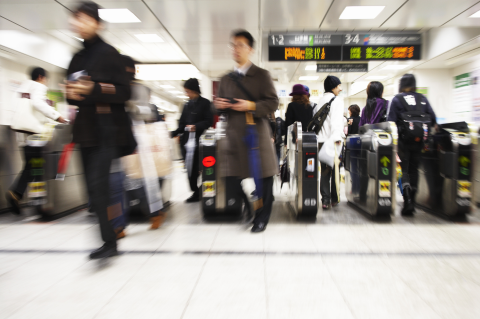
How could UWB transform transport ticketing experiences?
Date of publication: 06.05.2021
Author: Stefan Rüping, Distinguished Engineer, Security Chip Architectures

Crowd control during peak times in busy transport terminals is a significant challenge for operators and authorities. Without new technologies, it could get worse by 2050, when up to 70% of the world’s population is expected to live in urban locations, according to the UN. This will cause daily passenger numbers to grow, making quick and reliable ticketing for high passenger throughput absolutely critical.
How can operators and authorities maximise passenger throughput while providing adequate safety and security? One possibility is enabling a ‘touchless’ experience by augmenting NFC-enabled contactless solutions with UWB technology.

Resurrecting UWB
UWB itself is not a new creation. It was initially assessed for uses such as radar, and for communication uses like wireless file sharing. But it was concluded that other technologies were better suited.
Now, however, UWB has re-emerged. And it could change the face of public transport as we know it.
By sending and receiving radio waves with a very narrow pulse, UWB can identify – with far more accuracy than other technologies – how far one device is from another. This provides localisation capabilities (knowing where a particular ‘object’ is) as well as ‘ranging’ (knowing the distance between objects). These abilities make it well suited to supporting a better public transport experience.
Here are just a few other examples of UWB’s potentially limitless use cases:
- Hands-free access through ticketing gates and terminals
- Secured keyless entry to vehicles and buildings
- An added security layer for ATM use and contactless payments
- Location and movement analysis in professional sport
- Public transport network signalling
Major smartphone manufacturers like Apple, Samsung and Xiaomi already incorporate UWB capabilities into some of their latest devices. As the technology ends up in more consumers’ hands, PTOs should seriously consider the huge benefits it can bring as part of a robust, future-proofed ticketing strategy.
Levelling up passenger convenience
Contactless and digital ticketing is already a significant step up from paper-based ticketing. However, convenience does not stop at contactless. The next big step will be transitioning from contactless to an entirely touchless experience.
Imagine: passengers with a ticket securely stored on their mobile phone just walk up to the barriers, which open automatically as they approach, authenticating their ticket without even requiring them to take their device out of their bag or pocket. This is convenience in its purest form and something we believe consumers will love. When applied to peak travel situations, it’s clear that UWB could make a significant difference to crowd management and the user experience, removing bottlenecks and helping people get on with their day.
The transport ticketing technology family
NFC has supported the contactless ticketing revolution and is a familiar, trusted solution that accepts multiple payment forms. UWB will not replace it, but can work alongside it. UWB requires a smartphone be turned on in order for the technology to work, but with NFC, passengers can use their mobile to pay and/or gain access through barriers even if their battery has died.
UWB can also function well alongside Bluetooth Low Energy (BLE) technologies. BLE uses less energy in standby mode, so is the ideal choice to monitor for when a UWB-capable device comes within range, activating the technology so customers can pass through barriers and use public transport without breaking their stride.

The roadmap for UWB in transport ticketing
The widescale commercial applications of UWB are still in their infancy and our current priority is to capture system knowledge and explore all potential use cases.
As with any public service transformation, implementing UWB would require an infrastructure upgrade, not just at turnstile readers, but from device manufacturers who want to get the technology into customers’ hands. But the difference that UWB could make to the passenger experience is truly exciting and is an innovation that cannot be ignored.
Customers want to get from A to B with as little hassle as possible – UWB speaks directly to these desires and can make true touchless travel a reality.
Start your journey to digital ticketing today. Find out more here.

Date of publication: 06.05.2021
Author: Stefan Rüping, Distinguished Engineer, Security Chip Architectures
| Related links: |
Related external links: |
| OSPT Alliance | |
| CNA | |
| EMVCo | |
